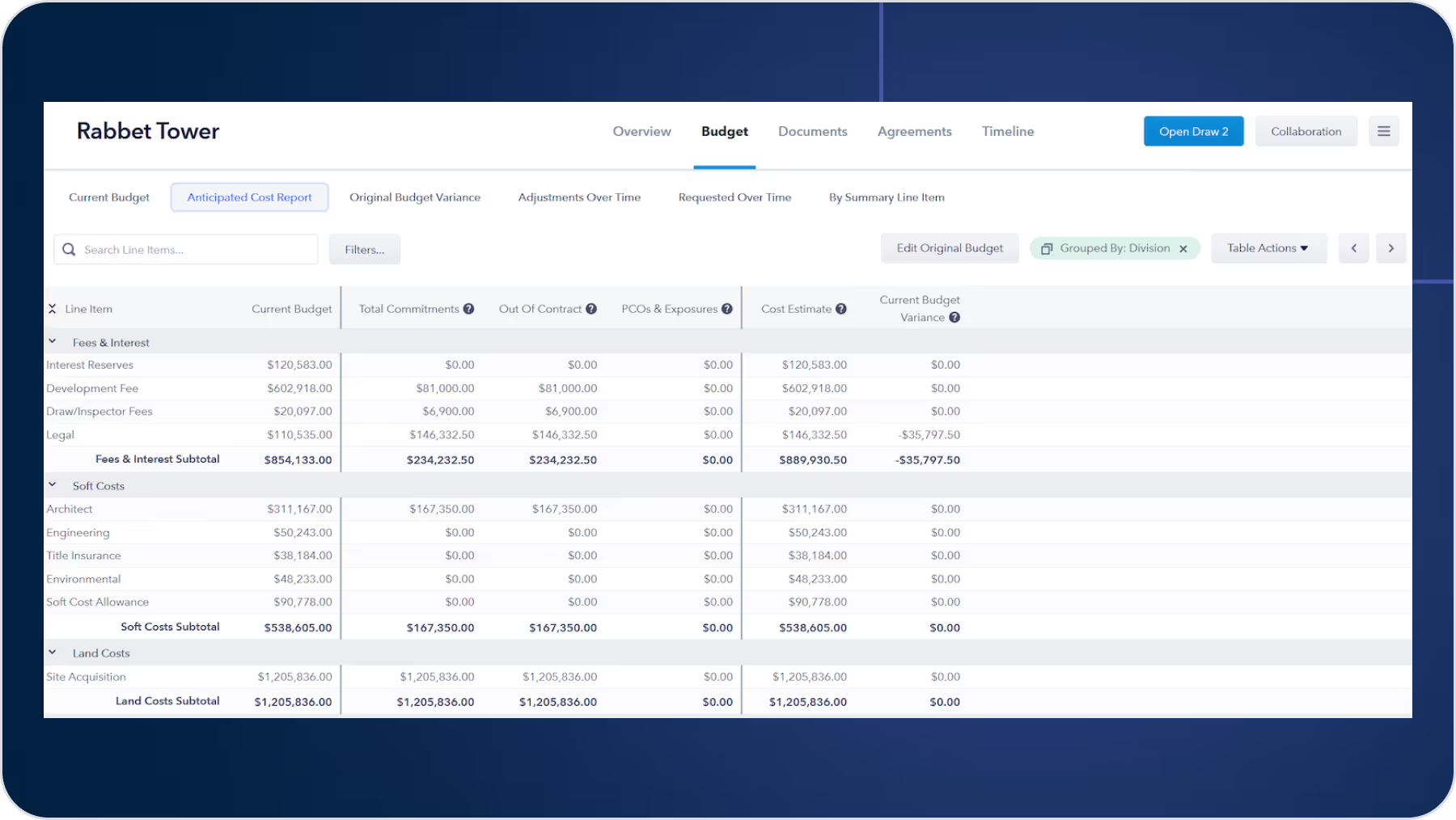Managing Your Budget and Anticipated Cost Reports

Embarking on a real estate development project is a complex and exhilarating journey. It's a venture that combines creativity, strategy, and resource management to transform visions into reality. From groundbreaking to ribbon-cutting, every step holds the promise of a thriving property that will stand as a testament to your vision and determination. However, amidst the excitement and anticipation, one aspect often stands as the bedrock of project success: budget tracking.
Picture this: a majestic skyscraper reaching for the sky or a serene community nestled amid lush landscapes. These captivating visions start as blueprints and evolve into tangible marvels. Yet, without vigilant oversight of financial matters, these dreams can quickly turn into costly nightmares. Budget tracking isn't merely an administrative chore; it's a strategic necessity that can make or break a real estate development endeavor.
In this blog, we will delve into the compelling reasons why meticulous budget tracking is the cornerstone of prosperous real estate development projects. From its role in ensuring fiscal discipline to its power in anticipating and mitigating potential challenges, we will uncover how budget tracking empowers developers, investors, and stakeholders to navigate the often unpredictable terrain of real estate development with confidence and finesse. So, let's embark on this exploration, where numbers tell a tale of triumph, and financial acumen lays the foundation for real estate success.
An Agreement on Definitions
In order to ensure alignment on our journey, we must initially agree on the key terms that are critical to success in this adventure. All of these items are critical to budget tracking excellence:
- Budget: A budget in a real estate development project is a financial plan that outlines the estimated costs and expenditures required to complete the project successfully. It serves as a guideline for managing expenses and ensuring that the project remains financially viable.
- Contract: A contract is a legally binding agreement between parties involved in a real estate development project. It outlines the terms, conditions, rights, and obligations of each party, including the scope of work, payment terms, and project milestones.
- Change Order: A change order is a formal document that outlines modifications or adjustments to the original scope of work, budget, or schedule of a real estate development project. It is typically initiated when there is a need to make changes due to unforeseen circumstances, design alterations, or client requests.
- Potential Change Order: A potential change order refers to a proposed modification to the project scope, budget, or schedule that has been identified but not yet officially approved. It is under consideration pending review and approval by relevant stakeholders.
- Exposure: Exposure in the context of a real estate development project refers to the potential financial risk or liability that the project stakeholders, such as investors, developers, or contractors, may face due to uncertainties, cost overruns, or other adverse events that could impact the project's budget or profitability.
- Contingency: Contingency serves as a financial buffer to cover unexpected expenses, scope modifications, market fluctuations, or any other uncertainties that could impact the project's cost or timeline. Contingency funds provide a safety net, allowing developers to respond effectively to challenges without jeopardizing the overall viability and success of the project.
- Anticipated Cost Report: An anticipated cost report is a financial projection that estimates the future costs of a real estate development project based on current progress and anticipated changes. It helps stakeholders understand and plan for potential expenses.
With these items outlined, we can now delve into how managing these items on a real estate development project is essential to ensure the project's financial success and minimize risks.
Best Practices to Ensure Project Success
With the ability to effectively centralize and compare the budget, contracts and costs, a developer can prevent future issues on a development project. This begins with the following key items:
Thorough Initial Feasibility Study
Conduct a comprehensive feasibility study before initiating the project. This study should include detailed cost estimates, market analysis, financial projections, and risk assessment. A well-informed decision at this stage can prevent unexpected budget overruns later.
Rabbet Recommendation: Review previous similar projects to understand where cost estimates proved incorrect.
Detailed Budgeting
Create a detailed and realistic budget that includes all possible costs, such as land acquisition, construction, permits, fees, design, marketing, contingency, and financing. Make sure to account for inflation and potential price fluctuations.
Rabbet Recommendation: Tracking the trades either at the breakdown of the General Contractor’s G703 or at minimum to 16 CSI Divisions.
Contingency Planning
Allocate a contingency fund within the budget to cover unexpected costs or changes in the project scope. A common rule of thumb is to allocate around 10-20% of the total project cost for contingencies.
Rabbet Recommendation: If the project is a Renovation, we recommend 10% contingency. New construction can have a 5% contingency depending on environmental studies.
Regular Cost Tracking
Implement a robust cost tracking and reporting system. Regularly monitor and compare actual expenses against the budget. This will help you identify cost overruns or discrepancies early, allowing for timely corrective actions.
Rabbet Recommendation: Track all budget, contract and cost information is a central location to check the interdependence of these items.
Value Engineering
Continuously review the project design and scope to identify opportunities for cost savings without compromising quality. Consider alternative materials, construction methods, and design elements that could reduce expenses.
Rabbet Recommendation: Involving your contractor early in these discussions specifically around material selection and submittal requirements can ensure material opportunities to improve deliverability and save costs on the project.
Vendor and Contractor Management
Establish strong relationships with reliable vendors and contractors. Obtain competitive bids and negotiate contracts carefully to ensure favorable terms and pricing.
Rabbet Recommendation: Review your history with various vendors on the project to see their history of project performance and proclivity for change orders.
Regular Project Meetings
Hold regular project meetings to review progress, address challenges, and ensure that the project is on track. Effective communication among team members can help prevent misunderstandings and costly mistakes.
Rabbet Recommendation: Understanding key RFIs, Submittals, and Lead Times can be a key impact on budget and should be paid close attention to.
Change Management
Implement a robust change management process to assess the impact of any changes to the project scope and budget. Obtain necessary approvals before implementing changes that could affect costs.
Rabbet Recommendation: Most contracts require the GC provide any Potential Change Orders within 21 days. Making sure you are getting regular updates from your GC on potential costs is important.
Regular Reporting to Stakeholders
Provide regular updates to stakeholders, including investors, lenders, and partners. Transparency about the project's financial status and progress can build trust and help garner support when needed.
Rabbet Recommendation: Closely monitoring the project contingency and ensuring the budget and contracts are being tracked properly will give confidence to stakeholders the project is moving forward as planned.
Leverage Technology
Use project management software and tools to streamline processes, enhance collaboration, and maintain accurate records of expenses, contracts, and project milestones.
Rabbet Recommendation: Use Rabbet.
By implementing these best practices, you can effectively manage your finances on your real estate development project and increase the likelihood of a successful outcome.
Tracking In Rabbet
Rabbet was built to ensure proper centralization of your information, to drive project insights, and ensure stakeholder confidence. This is done through three key steps:
- Detail Your Project Budget: Making it easy to track the proper detail of your project is the first key step. You can detail it for your use and then roll it up quickly for summary level to external parties.
- Properly Manage All Agreements: Whether it is a contract, a change order, or an exposure, tracking everything you have agreed to pay (and expect to pay) to vendors on a project is key for rolling up your project budget.
- Track All Costs to Agreements: As invoices and pay applications come in, you quickly ensure that not only the amount is in budget, but also in contract so you immediately know when vendors are exceeding their contracts or billing for out of contract costs.
Once you track the proper budget, agreement, and cost information, you can now easily visualize whether the project has enough budget (including contingency) through our various “Anticipated Cost Report” options. For this, let’s talk about how you can understand the various information and its relationship.

Current Budget versus Anticipated Costs versus Amount Paid and Remaining to Be Paid
Your current budget on the project is the original budget net any reallocations / adjustments you have done to get to your current budget. Ideally your current budget is always greater than your Anticipated Costs which are the net of all of your contract commitments (contracts and executed change orders) + potential change orders + exposures + out of contract costs. Your potential total costs can also be viewed by looking at the amount that has been requested to date and any remaining potential change orders and exposures.
By comparing the total of current budget and anticipated costs (either by contract or amounts paid to date), you can confirm the amount of money remaining is sufficient to cover the budget and then simply reallocate the money from line items that have surplus and contingency to line items that have an overrun.
To simplify this comparison, we have created the “Anticipated Exposures” column that finds the greater of the Current Budget and the Anticipated Costs or the Amount Requested and Outstanding Agreements (Potential Change Orders, Exposures, and Out of Contract costs). If Anticipated Exposures are the SAME as your Current Budget, you are in good shape.
Tracking Your Anticipated Budget
If you prefer to have your budget be exclusive of Outstanding Agreements, we have created the Anticipated Budget column that finds the Greater of the Current Budget and Committed Costs and adds the Outstanding Agreements to calculate the true Anticipated Budget if you are NOT accounting for Outstanding Agreements in your budget adjustments.
Rabbet Recommendation: We recommend that you try to account for Outstanding Agreements as soon as they come up and therefore recommend the use of Anticipated Exposures in the Anticipated Costs Report.
Conclusion
As we wrap up this exploration into the realm of budget management and anticipated cost reports in real estate development projects, we're reminded of the pivotal role these practices play in the successful execution of your ventures. The journey from vision to reality is one laden with potential challenges, twists, and turns, and it is through meticulous financial oversight that you can navigate this path with confidence and finesse.
Your journey begins with establishing a robust budget that comprehensively captures the myriad costs involved in bringing your vision to life. This budget serves not only as a financial guide but as a strategic map that ensures fiscal discipline, accurate cost estimation, and a solid foundation for decision-making.
Contracts, change orders, and exposures weave the intricate fabric of your project's financial landscape. Vigilant management of these elements ensures that your project remains aligned with your vision while adapting to the dynamic circumstances that are inherent in real estate development. By exercising prudent vendor and contractor management, proactive change management, and transparent reporting to stakeholders, you bolster your project's resilience and its ability to thrive in the face of uncertainties.
And at the heart of it all lies the power of technology. Leveraging advanced project management tools such as Rabbet enables you to centralize, track, and analyze your budget, agreements, and costs in real-time. This empowers you with actionable insights and foresight, transforming data into a strategic advantage.
As you embark on your next real estate development journey, armed with the knowledge shared in this blog post, remember that budget tracking and anticipated cost reports are not just administrative tasks – they are your compass, your shield, and your key to turning dreams into tangible success stories. By embracing these practices, you're not only ensuring financial prudence but also forging a path towards a legacy that stands as a testament to your vision, resilience, and expertise.
So go forth, navigate the challenges, and let your budget and anticipated cost reports be your guiding stars on this thrilling voyage through the world of real estate development. Your success awaits on the horizon, and with the right tools and strategies, you're poised to seize it. Happy developing!
















